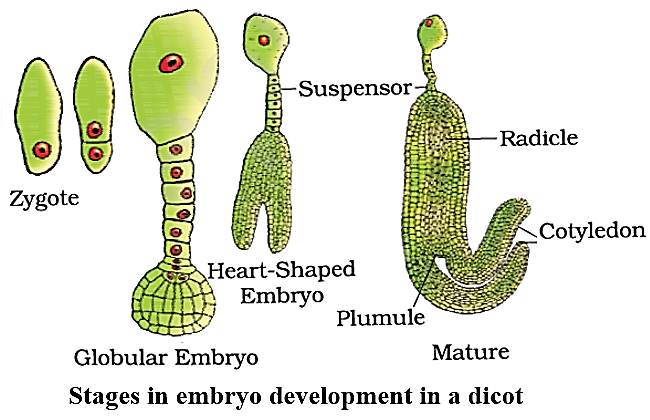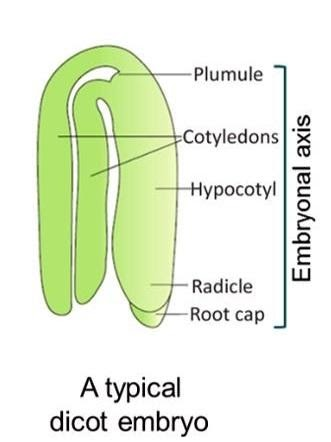
A seed contains?
Answer
510k+ views
Hint: The formation of seed is a part of the process of post reproductive events. A seed (ripened ovule) is an embryonic plant enclosed in protective outer coverings called as seed coats that are developed from integuments of ovule. It also has an embryo that has developed from zygote and endosperm in the form of stored food to provide nutrition to the developing embryo.
Complete answer:

Seed coat: The integuments of ovule form the coverings of seed, the seed coats. The outer covering is Testa and the inner one is the Tegmen. A third integument present in litchi called as ‘Axile’ is its edible part.
Embryo: On the micropylar end the zygote develops into an embryo. Only after certain endosperm amounts form is most of the zygote divided. This adjustment ensures that the developing embryo receives safe nutrition. The early stages of embryo development are similar in dicots and monocots. The zygote divides mitotically first to form proembryo then to \[16 - 32\] celled globular embryo followed by heart shaped embryo and then at last a mature embryo.

An embryo has cotyledon and an embryonal axis. One cotyledon is present in monocots and \[2\] in dicots.
Dicots: The portion of embryonal axis above cotyledon is called epicotyl and the cylindrical portion below the level of cotyledon is hypocotyl. The tip of epicotyl is plumule which is the shoot apex and the base of hypocotyl is radicle which is root apex, which is covered by root cap.
Monocots: They have a single shield shaped cotyledon called scutellum which is present lateral to the embryonal axis. The reduced cotyledon is called epiblast. A hollow foliar structure enclosing a primordial leaf is the coleoptile. Coleorhiza is an undifferentiated sheath that encloses the root cap.


Endosperm: Seeds can be Endospermic/ Albuminous or Non-endospermic/Non-albuminous.
Endospermic: The endosperm is not completely consumed and generally found in monocots ex. wheat, barley, maize, etc. Also found in castor (dicot).
Non-Endospermic: The endosperm is completely consumed during embryo development. Generally observed in dicots ex. pea, groundnut, beans, etc. Also found in orchids (monocot).
The coconut water is free nuclear endosperm, made of thousands of nuclei therefore very nutritive.
So, A seed is a fertilized ovule. It has a seed coat (outer and inner), an embryo, and endosperm (stored food).
Note:
Micropyle is retained in seed after fertilization to allow gaseous exchange for entry of water and oxygen into seed during germination. As the seed matures, it becomes dry by about \[10 - 15\% \] (by mass). The general metabolic activities slow down. The embryo may enter a stage of inactivity called dormancy. The seed germinates in favorable conditions (adequate moisture, \[{O_2}\], temperature).
Complete answer:

Seed coat: The integuments of ovule form the coverings of seed, the seed coats. The outer covering is Testa and the inner one is the Tegmen. A third integument present in litchi called as ‘Axile’ is its edible part.
Embryo: On the micropylar end the zygote develops into an embryo. Only after certain endosperm amounts form is most of the zygote divided. This adjustment ensures that the developing embryo receives safe nutrition. The early stages of embryo development are similar in dicots and monocots. The zygote divides mitotically first to form proembryo then to \[16 - 32\] celled globular embryo followed by heart shaped embryo and then at last a mature embryo.

An embryo has cotyledon and an embryonal axis. One cotyledon is present in monocots and \[2\] in dicots.
Dicots: The portion of embryonal axis above cotyledon is called epicotyl and the cylindrical portion below the level of cotyledon is hypocotyl. The tip of epicotyl is plumule which is the shoot apex and the base of hypocotyl is radicle which is root apex, which is covered by root cap.
Monocots: They have a single shield shaped cotyledon called scutellum which is present lateral to the embryonal axis. The reduced cotyledon is called epiblast. A hollow foliar structure enclosing a primordial leaf is the coleoptile. Coleorhiza is an undifferentiated sheath that encloses the root cap.


Endosperm: Seeds can be Endospermic/ Albuminous or Non-endospermic/Non-albuminous.
Endospermic: The endosperm is not completely consumed and generally found in monocots ex. wheat, barley, maize, etc. Also found in castor (dicot).
Non-Endospermic: The endosperm is completely consumed during embryo development. Generally observed in dicots ex. pea, groundnut, beans, etc. Also found in orchids (monocot).
The coconut water is free nuclear endosperm, made of thousands of nuclei therefore very nutritive.
So, A seed is a fertilized ovule. It has a seed coat (outer and inner), an embryo, and endosperm (stored food).
Note:
Micropyle is retained in seed after fertilization to allow gaseous exchange for entry of water and oxygen into seed during germination. As the seed matures, it becomes dry by about \[10 - 15\% \] (by mass). The general metabolic activities slow down. The embryo may enter a stage of inactivity called dormancy. The seed germinates in favorable conditions (adequate moisture, \[{O_2}\], temperature).
Recently Updated Pages
The number of solutions in x in 02pi for which sqrt class 12 maths CBSE

Write any two methods of preparation of phenol Give class 12 chemistry CBSE

Differentiate between action potential and resting class 12 biology CBSE

Two plane mirrors arranged at right angles to each class 12 physics CBSE

Which of the following molecules is are chiral A I class 12 chemistry CBSE

Name different types of neurons and give one function class 12 biology CBSE

Trending doubts
One Metric ton is equal to kg A 10000 B 1000 C 100 class 11 physics CBSE

What is 1s 2s 2p 3s 3p class 11 chemistry CBSE

Discuss the various forms of bacteria class 11 biology CBSE

State the laws of reflection of light

Explain zero factorial class 11 maths CBSE

An example of chemosynthetic bacteria is A E coli B class 11 biology CBSE




